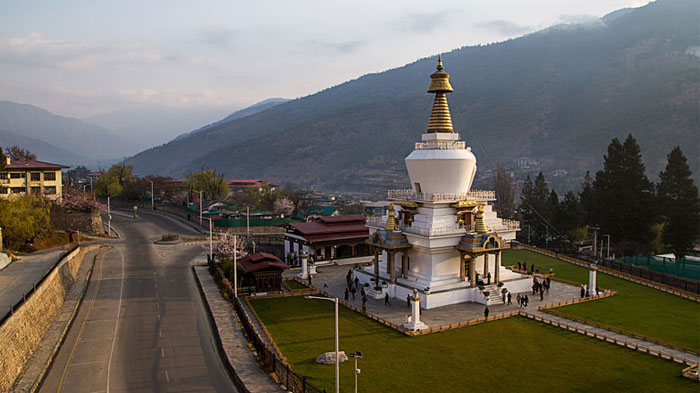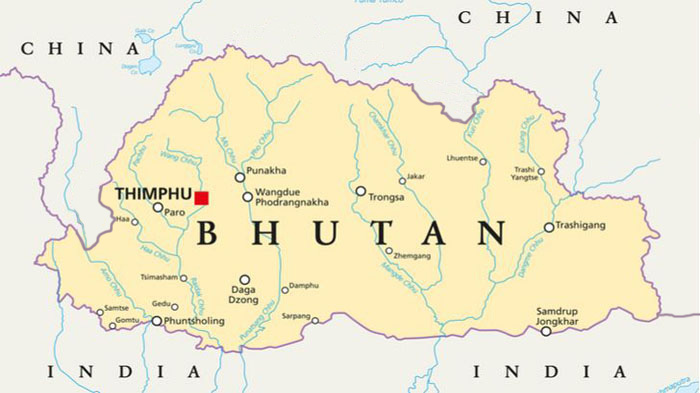
Bhutan Road Conditions: what you should know for travel?
The single most isolated country in the world, the Kingdom of Bhutan lies on the southern edge of the eastern Himalayas, sandwiched between Tibet to the north and India to the south. However, for a country that prides itself on its exclusive tourism industry and protection of the natural environment, there are actually very few roads in Bhutan. It was not until 1961 that the First Development Plan began, with the 175-kilometer paved road from Phuentsholing to Thimphu, which later had a branch road linking the main road to Paro.
With only 8,050 kilometers (5,000 miles) of roads completed in the kingdom, only around 60 percent are actually paved with concrete or asphalt. The main road through Bhutan is the East-West Highway, locally known as the Lateral Road, which runs from Phuentsholing on the border with India in southwest Bhutan to Trashigang in the east. This road has spurs to cities like Thimphu, Punakha, and Paro, and is widely used for most travel from east to west in the country. Please follow our expert’s guide to learn more of the Bhutan Road condition so as to better plan your Bhutan tour.
Bhutan Road Condition and its Unique Geography
Bhutan is a hilly and mountainous country that sits in the foothills and lower mountains of the Himalayas. Roads tend to go up and down mountains, along valleys, and through high mountain passes, and are winding and often dangerous, as they rarely have more than one lane. Bhutan is not a place where high speeds can be maintained, hence the maximum speed limit of just 50km/h on roads outside the towns and cities. And given that the roads are mostly up and down mountains and winding with sharp hairpin bends, going more than a snail’s pace would indeed be reckless in the extreme. Though why you would want to with the stunning scenery all around you is anyone’s guess.
 Winding road tend to go up and down mountains, along valleys in Bhutan.
Winding road tend to go up and down mountains, along valleys in Bhutan.
Western Bhutan actually has more highways than anywhere else, with paved roads connecting Thimphu with Paro and Punakha, all the way out to Ha in the west, and southwest to Chukha and Phuentsholing. In the central region, aside from the Lateral Highway, paved roads head only to Wangdue Phodrang and Zhemgang, extending south as far as Gelephu and Sarpang for the border crossings into India. Similarly, Eastern Bhutan has fewer roads, with spurs from the Lateral Road to Trashigang heading north to Trashiyangtse and Lhuntse, and south the Pemagatshel and Samdrup Jongkhar.
Bhutan Road Condition for Classic Paro, Punakha, Thimphu Tour
The road between Paro, Thimphu, and Punakha is actually rated as one of the best roads in the kingdom, especially the section between Paro International Airport and the capital of Thimphu, which is now an improved two-lane highway. Inside the picturesque Paro Valley, the roads are smooth and paved with asphalt, which is easier for driving, while the route to Thimphu is on a two-lane blacktop that is one of the best-used roads in the country, since all visitors enter through Paro Airport. A distance of around 51 kilometers, this well-used road means you can make t to the capital from the airport in around 1 hour 20 minutes.
 Well-paved road in Thimphu
Well-paved road in Thimphu
From Thimphu to Punakha, the road is not quite as good, despite being called a “highway”. A mix of old paved road and dirt or gravel tracks, the entire 75-kilometer distance from Thimphu to Punakha can take as much as 3-3.5 hours to complete. One of the best-paved parts of this road is the section that leads up to and down from the Dochu La Pass, at 3,100 meters, with its 108 chortens, as this is a major tourist attraction in the area. The highest pass along this route from Paro all the way to Punakha, you can actually see the higher mountains of the Himalayas from the top, including the highest mountain in Bhutan, Mount Gangkhar Puensum.
>> Find out the top Bhutan cities to visit.
Bhutan Road Condition for Mountain Biking
If you are planning to go mountain biking in Bhutan, then you are in for a rare treat. Few places in the world have the stunning landscapes required for the best in mountain biking, as well as some of the greatest mountain areas for biking through.
If you are biking around the area of Paro, then you are in luck when it comes to road conditions. The roads in Paro are better than in most places in Bhutan, with perhaps the exception of Thimphu. The road for the Paro-Haa-Paro run is a good asphalt road with only a few stretch of dirt roads, while the road out of Paro heading northwest along the Paro Valley, which is a popular biking trail, is around half asphalt and half gravel.
 Enjoy the thrilling mountain biking in the trails of Paro.
Enjoy the thrilling mountain biking in the trails of Paro.
The biking trail from Paro to Thimphu follows the route of the newer highway, a two-lane blacktop that runs the 51 kilometers to the capital. Following the valleys heading southeast from Paro, and then turning northeast towards Thimphu at the Paro-Thimphu Bridge over the Wang Chu, the road is a delightfully easy route for even a novice cyclist.
The main biking trail in Punakha leaves the small village of Sopsokha and heads down through the Punakha Valley to the town of Wangdue Phodrang, before heading up along the Punakha Valley past the famous Punakha Dzong. While the road is not the best in Bhutan, it is actually far from the worst, and around half of the route is paved, mostly in the lower reaches around Punakha and Wangdue Phodrang.
Bhutan Road Condition for Trekking
While the Druk Path Trek may be one of the best treks in Bhutan, getting it is really simple, and in terms of road conditions, is about average. The road from Paro center to the start of the trailhead at the Ta Dzong National Museum is asphalt for some of the distance, though mostly coated in silt and dirt from the sides of the hills.
 Trek in Jhangothang region along the winding road in Bhutan
Trek in Jhangothang region along the winding road in Bhutan
Head north out of Paro along the Paro Chu and you will come to the side road that leads to the Taktsang Monastery, halfway up the cliff overlooking the valley. The road is asphalted along the whole distance, right up to the car park where you will start the hike to the Tiger’s Nest Monastery. A little dirty, the road does have some major potholes, and is in need of some repair in some sections.
Heading north from Paro, the road towards the trailhead for the Jomolhari trek, the Snowman Trek, and the Laya Gasa Trek is relatively decent, with only a few rough patches, despite being an older road. However, once you reach the end of the road, you are still a good kilometer from the Drukgyel Monastery, where the trek starts, and the only way to get there is to walk along the narrow path through the woodlands.
Bhutan Road Condition for Border Entry
Entering Bhutan overland means heading through one of the three border crossing points along the southern border with India. The three crossings are located at Phuentsholing, Gelephu, and Samdrup Jongkhar.
 Three border cities are situated in the south of Bhutan, neighboring borderline of India.
Three border cities are situated in the south of Bhutan, neighboring borderline of India.
Traveling from Phuentsholing to Thimphu is a lot better now than it used to be, as the road has been greatly improved thanks to the increase in tourism in the kingdom. A scenic trip that takes around 4 hours 30 minutes to cover the 165 kilometers to the capital, the road is one of averagely paved asphalt for most of the distance to the capital. There are a few rougher patches along the road, especially as it climbs up and down some of the mountains, but overall, the route is one of the better roads in Bhutan. Well-used, the road is, however, a single lane road for most of the route to Thimphu, only having two lanes closer to both Phuentsholing and the capital. - Check how to prepare a Bhutan tour from Delhi.
The road from Gelephu to Thimphu is a 243-kilometer route that can take more than 8 hours to get to the capital. Not one of the most popular routes for entering and leaving Bhutan, the road to Gelephu is actually fairly well paved now, and is asphalt for the entire length. However, the edges of the roads are rough and worn, with potholes and gravel sides, and it is only a single lane road for the entire distance, including the section on the Lateral Road.
If you are thinking of traveling through Samdrup Jongkhar to get into Bhutan, then be prepared to be disappointed. While there is a border crossing at Samdrup Jongkhar, the road inside Bhutan that leads north from the border ends at Pemagatshel, and does not head north to join the Lateral Road to get to Thimphu.
Conclusion
Traveling in Bhutan is an unusual experience, and you should not expect the type of roads that you can find in western countries, or even in most of the Asian countries. Bhutan is still in the process of improving its road network, and upgrading from dirt and gravel roads to asphalt is expected to take some years to complete. And even then, you will find many areas that still will not have asphalt roads, as they are not well-used enough to warrant paving. Fortunately, international travelers are not permitted to drive in Bhutan, and all the tour drivers are well trained and very experienced, so you can rest assured in the comfort of your tour vehicle that the driver will get you where you are headed safely.

I am a tour guide in Tibet an was Born in Kham Tibet, I am the father of 2 little girls, bachelor's degree. I have more than 7-years experience of being a tour guide in Tibet. I am a warm, friendly, knowledgeable and attractive guy.


.jpg)



0 Comment ON "Bhutan Road Conditions: what you should know for travel? "